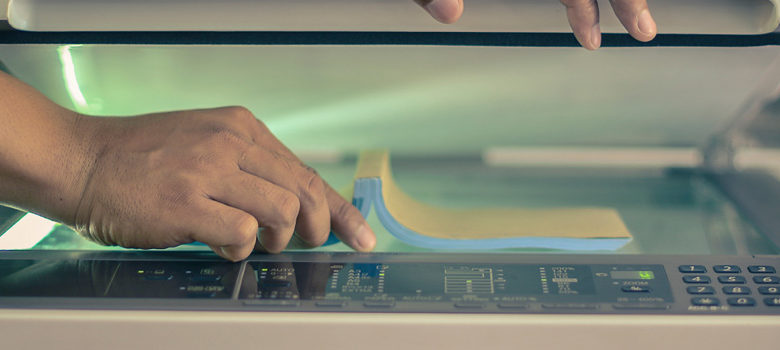
In today’s computer age, image scanners are one of the most important tools used in converting physical media to digital form, allowing for easy distribution and preservation. While modern scanners can be extremely powerful, able to reproduce extremely high dots per inch (DPI) copies of media in seconds, scanning was not always so quick and cost efficient. The idea of copying and easily transmitting images dates several decades before the advent of computing.
The first attempts to reproduce images were not digital. Instead, analog approaches were taken by early developments in facsimile technology. In 1843, Alexander Bain patented an experimental facsimile machine, and the first commercial fax service was opened by the French telegraph administration in 1865. Widely used throughout the early 20th century, early facsimile devices allowed for the easy transfer of photographs, maps and other imagery.
After World War II, the development of electronic digital computers throughout the 1940s and 1950s led to research in many emerging fields, including image reproduction. Research in computer image processing began with the National Bureau of Standards work on the Standards Electronic Automatic Computer (SEAC). Built in 1954, the SEAC was the first internally stored program computer operated by the United States government. Initially developed to solve problems in mathematics and chemistry, the SEAC was also used to explore novel areas in computing, such as problems in artificial intelligence and language processing. Russell Kirsch led a team of researchers to explore character recognition technology for the purpose of processing mass amounts of data. Based on contemporary models of neurophysiology, Kirsch’s team constructed the first picture scanner in 1957 using binary representation of image data.
 |
The scanner used a rotating drum and photomultiplier to detect reflections from an image mounted on its drum, with a mask between the picture and photomultiplier to parse the image into discrete square pixels. The SEAC’s memory allowed images to be displayed on cathode ray oscilloscopes, which quickly revealed the limitations of binary image representation. The SEAC’s memory was only able to parse a 176 x 176 square. Usage of square pixels is a legacy that continues in image processing to this day. Kirsch has since stated that the decision to use square pixels was a mistake, and that square pixelation leads to decreased quality in images. In retrospect, Kirsch would have preferred to take an approach similar to the sixth century mosaics in Ravenna, which used a technique of tesserae with different shapes and colors to represent an image. Using individually shaped tesserae versus square pixels allows for greater image quality using the same amount of discrete points. An 80 x 46 tesserae image for example, can represent a picture in higher quality than the same image represented by 100 x 58 square pixels.
 |
The SEAC’s work in image processing encouraged research in other aspects of image processing, including CAT and MRI scanners. A next major step in the development of image scanners came in 1970 with Boyle and Smith’s invention of the charge-coupled device (CCD), an integrated circuit chip that captures and stores light, displaying it by converting it to an electrical charge. CCDs found many uses, including in digital photography, but they were also a natural fit for computer image processing. The first CCD-based flatbed scanner was developed by Ray Kurzweil in 1975. Kurzweil had previously developed a system of optical character recognition (OCR) to discern letters in numerous fonts, whereas previous OCR programs could only recognize one or two type fonts. In 1976, Kurzweil integrated his OCR and scanning technologies with a text-to-speech synthesizer called the Kurzweil Reading Machine. The three components of the machine were intended to work together to assist vision-impaired people in reading physical documents.
 |
Flatbed scanners were initially very expensive, to the point of being cost prohibitive to most consumers. The 1980s saw the introduction of hand-held and pen scanners as a more cost-effective alternative to flatbed scanners, but these devices often proved difficult to use. With many of these devices, the accuracy of a scan was dependent on how steadily people could move their hands across a document. The price of flatbed scanners decreased throughout the 1990s, and the popularity of hand-held scanners declined with it.
 |
Today, flatbed scanners comprise the vast majority of scanners. While many have the ability to scan different kinds of media inexpensively, there still remains a market for drum scanners. Modern drum scanners are able to produce a far more accurate picture at a much higher DPI than flatbed scanners, and have niche uses for reproducing various kinds of special documents.
2016 marks the 40th anniversary of Kurzweil’s Reading Machine, and while the basic principles behind much of today’s scanning equipment are not that different from the approaches taken by Kurzweil and Kirsch, problems in OCR and text-to-speech remain an area of active research. Additionally, the rapidly emerging 3-D printing and scanning industry creates a need to capture objects beyond two dimensional representations. The 21st century is an increasingly digital age, and as computing power increases, the challenges of digitally representing our environment will continue to increase in complexity and importance.
References and Further Reading
Coopersmith, Jonathan, “Fax Machines,” https://ethw.org/Fax_Machines
Kurzweil, Ray, “The Age of Spiritual Machines,” https://en.wikipedia.org/wiki/The_Age_of_Spiritual_Machines
Woods, Steve, “Russell Kirsch: The man who taught computers to see,” The Oregonian, https://www.oregonlive.com/living/index.ssf/2007/05/russell_kirsch_the_man_who_tau.html
Nathan Brewer is digital content manager at the IEEE History Center at the Stevens Institute of Technology in Hoboken, N.J. Visit the IEEE History Center’s Web page at: https://www.ieee.org/about/history_center/index.html.






